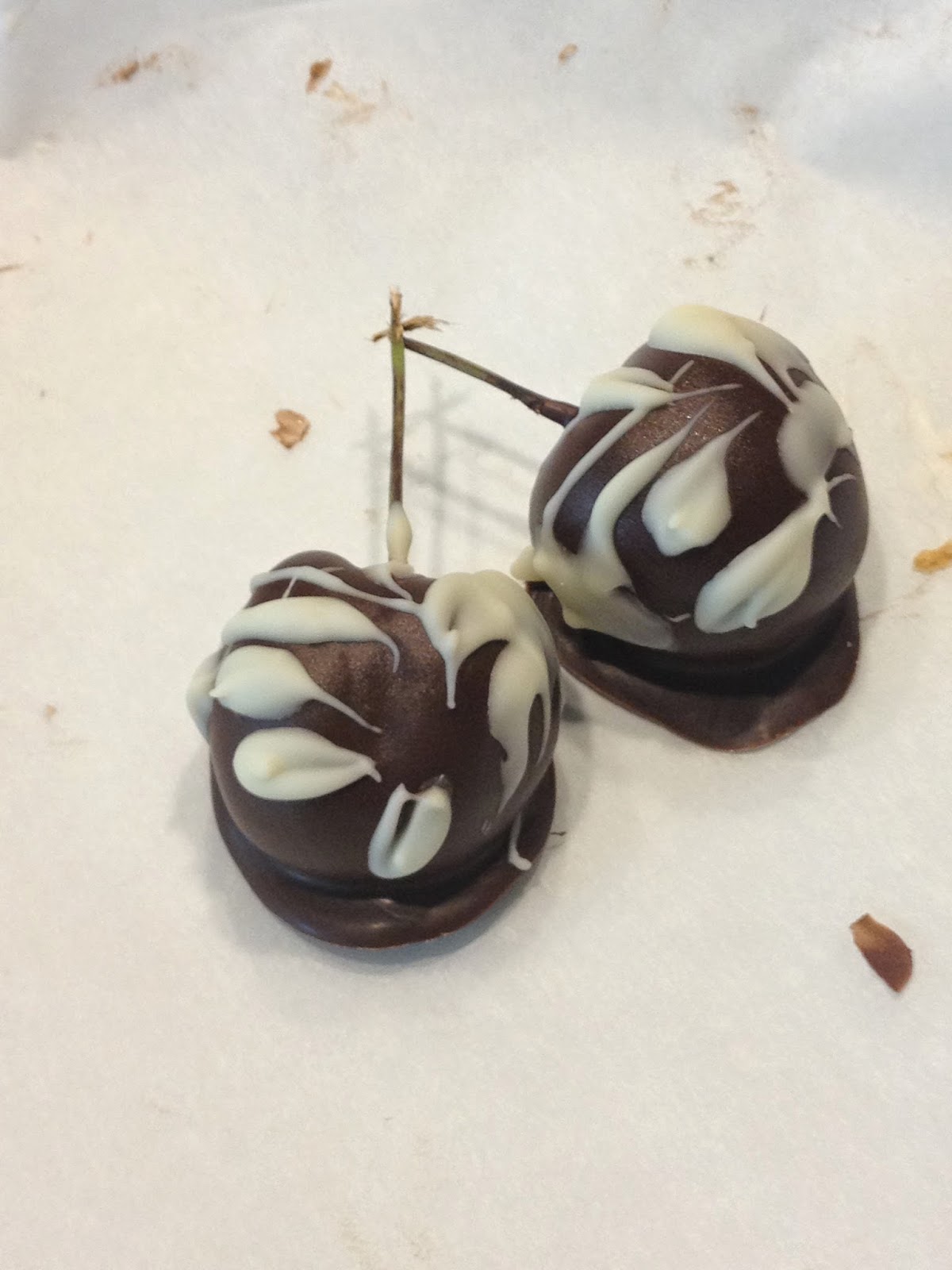Chocolate-Dipped Variety Plate
Ingredients
Chocolate of your choice – milk chocolate, dark chocolate,
bittersweet, semi-sweet, etc.
White chocolate (If you want the pretties)
Stuff you’re going to dip into chocolate (fruit,
marshmallows, s’more sandwiches, pretzels, cookies, bacon, anything you want,
really.)
Fruit (any kind you want dipped in chocolate, but
fresh is always best)
Fresh cherries
Fresh strawberries (giant strawberries are not ideal – the flavor
is less concentrated and you will have a smaller surface to volume ratio – more
strawberry, less chocolate shell!)
Fresh blueberries
Toothpicks (round, pointy ends)
S’more Sandwiches
Original graham crackers
Marshmallows (I used flat stacker marshmallows)
We can break this project into four steps.
I’ll talk about how to melt, dip and set the chocolate
shell. Then I’ll get into how to make
the S’more sandwiches you’ll be dipping, and then how to prepare the blueberries
for dipping. Finally, we’ll cover how to
make your chocolate creations even prettier with white chocolate accents.
Dipping things into chocolate is almost criminally
easy. Melt, dip, chill for 15-20 minutes
to harden and set.
 |
| Chilling in the fridge |
- Simply place your desired chocolate in a microwaveable bowl. You’ll want a bowl that is deep enough that you can dip your treats in to cover, while still being wide enough to get your treats into the chocolate. I used a one cup Pyrex measuring bowl.
- Take about six to seven ounces of chocolate (chopped roughly or broken into chunks), and microwave in intervals of 30 seconds, stirring in between bursts until the melted chocolate is smooth and all the chunks have melted away. Take care not to burn the chocolate!
- Spread out some parchment paper on your counter top – this will cut down on mess.
- Think about how many treats you want to dip, and then line a plate with parchment paper that’s large enough to hold your treats. If it not big enough, that’s okay. You can work in batches. The key is to have some room in your fridge for the plate you’ll chill your dipped treats on.
- Now that you’ve got your plate ready, dip your treats into the chocolate, let the excess drip off, and then place on the parchment paper-lined plate. Repeat until your plate is full, or you’ve run out of treats. Make sure to space your dipped treats so they’re not touching, and so the chocolate off-drip does not touch either.
- As you dip, if you’re running low, you can melt more chocolate. If you’re running low on both chocolate and undipped treats, go ahead and just smear the outside with what’s left. All you need is a chocolate coat – it doesn’t have to be dipped!
- It’s helpful to leave a small part of the treat undipped to serve as a handle – less chocolate will melt on your hands. If using fruit, keep the stems on, and you’ll be fine.
- Place the plate in the fridge for 15-20 minutes to let the chocolate harden and set. Once you’ve done that, you can peel the treats off the paper, and the chocolate will stay hard!
- I recommend keeping dipped fruit in the fridge, but nonperishables will keep fine in the pantry.
Blueberry Skewers!
- Spear four blueberries on one end of a toothpick, with that end only just poking past the end berry. You don’t want to lose a berry in the chocolate!
- Dip the skewer in chocolate, let set.
S’mores Sandwiches
- Break the crackers into rectangles, two for each sandwich.
- Line a baking sheet with parchment paper.
- For each sandwich, place one cracker piece on the tray, add one marshmallow on top.
- Put the tray in the oven, and broil until the marshmallows are golden to dark brown. Watch the oven carefully so they don’t burn!
- When you’ve toasted the marshmallows to your liking, remove from oven and allow to cool until the marshmallows are slightly firmer when you poke at them.
- Take the top cracker, smear with melted chocolate, and gently smush on top of the marshmallow. Let the baking tray cool, and then put in the fridge for 15-20 minutes to let the chocolate mortar set.
- Dip in chocolate, put back in fridge for 15-20 minutes to harden and set, and your chocolate dipped s’mores are done!
White Chocolate accents
- To add a fancy element to your treats, melt white chocolate and decorate as you like.
- For the strawberries and cherries, I make sure the white chocolate is melted and liquidy, and then use a chopstick end to decoratively drizzle white chocolate on the dark chocolate shell.
- I dip the end of the blueberry skewers with white chocolate. I do this at the end, when the chocolate has cooled enough that the darker chocolate will not melt on contact.
- Once you’ve added your white chocolate accents, chill to set as usual, and enjoy.





